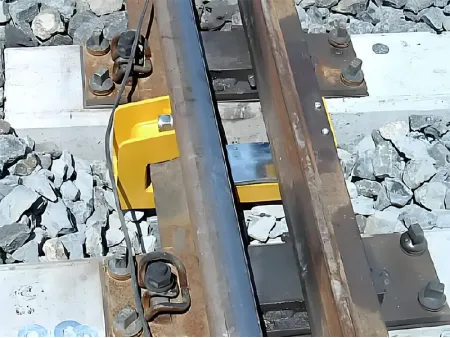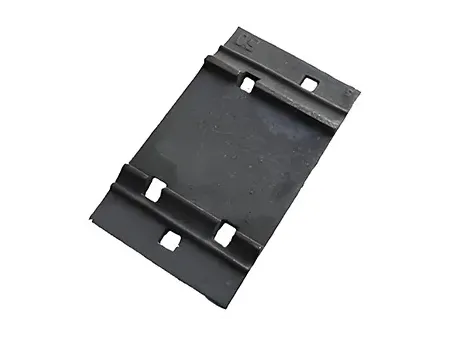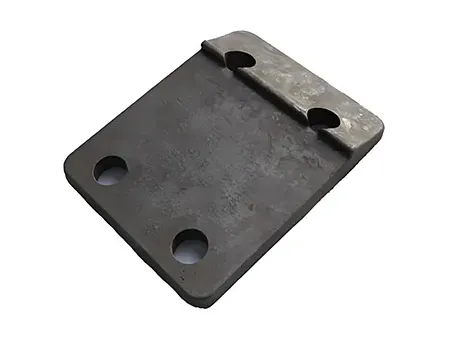Tie Plate
A tie plate is also called a baseplate or sole plate. SUYU specializes in producing rail fastening and tie plate is one of our main products. Rail tie plate is used in rail construction to support the rails. We can offer rail tie plate made using either casting iron or casting steel for customers to choose from, depending on the load and the type of rails. Boltable as well as weldable clips can be applied. For the discontinuous type of support, we supply various ribbed tie plate which are also produced in casting iron or casting steel.
Tie plates are generally used to take the load of rail and distribute the load to the sleepers offering proven economies. We manufacture all types of base plates suitable for various rail sections, for use on wooden, steel or concrete sleepers and ballast-less tracks used with elastic fastenings on wooden sleepers and 'K' type fastening system.
Cast iron can be the welded or fabricated type, depending upon the customers requirements. Our rail tie plate can be made to suit various rail section, i.e. UIC 60, UIC 54, RN 45, 90 A, etc.
Tie plate or sole plates are needed in rail installation, as they not only support the rails, but also enable the entire fastening system to be fixed on. Rail tie plates are the uppermost component of a crane rail or track support system. The primary function of a tie plate or sole plate is to provide the rail with a flat, smooth resting surface while allowing for vertical alignment of the rail system. Tie plates are secured by Anchor Bolts, also known as Holding Down Bolts. Soleplates are typically installed with a layer of grout cast beneath, which fills the void between the soleplate and the concrete foundation.
The holes for bolting the anchor and leveling bolts, and holes for bolt through clips if present, are precisely drilled into the sole plates. For weldable clips and base clips, the bottom of the clip is welded onto the sole plates before galvanizing.
We can manufacture any quantities big or small and try to accommodate our customer requests, although it is more economical to manufacture larger quantities.
| Type | Dimension | Holes | Incline | Rail | Weight(Kg) |
| 345/285/127/160x15/13 | Ø 26 (4x) | 1:40 | S 49/S 54 | 7,86 | |
| 345/285/127/160x15/13 | Ø 26 (4x) | 1:40 | S 49/S 54 | 7,70 | |
| 345/285/127x210x15/13 | Ø 26 (4x) | 1:40 | S 49/S 54 | 10,55 | |
| 345/285/127x210x15/13 | Ø 36,3 (2x) | 1:40 | S 49/S 54 | 10,55 | |
| 345/285/127x210x15/13 | Ø 26 (4x) | 1:40 | S 49/S 54 | 10,69 | |
| 345/350/127x410x15/13 | Ø 26 (8x) | 1:40 | UIC 60 | 20,60 | |
| 370/310/152x160x15/13 | Ø 26 (4x) | 1:40 | UIC 60 | 8,44 | |
| 370/310/152x210x15/13 | Ø 26 (4x) | 1:40 | UIC 60 | 11,32 | |
| 370/350/152x420x15/13 | Ø 26 (8x) | 1:40 | UIC 60 | 22,73 | |
| 664/554x160 | Ø 26 (4x) | 1:40 | S 54 | 15,37 | |
| 690/570x160 | Ø 26 (4x) | 1:40 | UIC 60 | 15,27 | |
| 345/285/127x160x15/13 | Ø 26 (4x) | 1:20 | S 49/S 54 | 8 |
Adhering to our quality first policy, SUYU pays great attention to quality control management on our tie plate. We have been granted ISO9001-2008 certificates and have received the production license of China's Railway Ministry on railway products. We have a full set of inspection instruments to ensure all our rail tie plates are of high quality and up to customers' requirements.
As a leading manufacturer of rail fastening based in China, SUYU also produces many other railway fasteners, such as track bolt, sleeper screw, rail joint bar, rail anchor, rail clip, elastic rail clip, SKL tension clamp, rail shoulder, and so on.




